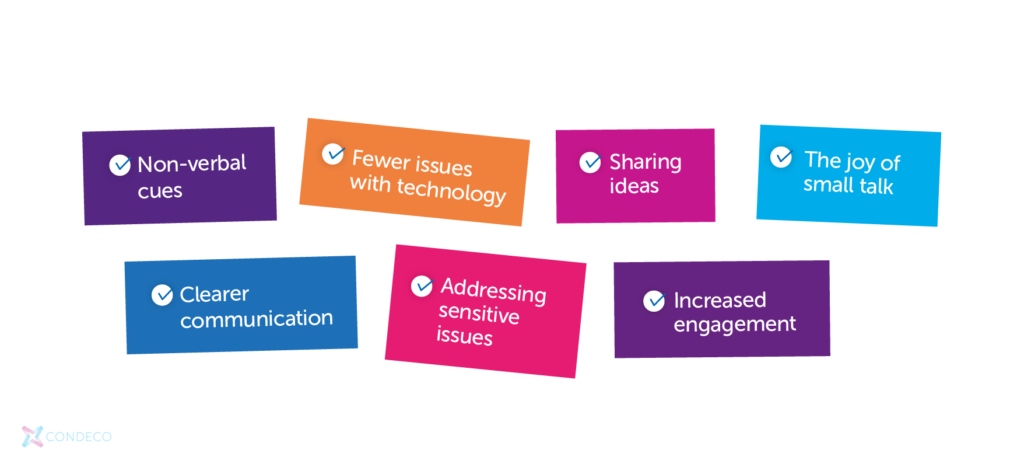
Could we live in a world where we never meet our work colleagues in person?

Technology has certainly made that possible and recent years have shown how feasible it is for many businesses to run productively when everyone is based in their homes. But when we have the choice to meet in person, should we take it? Condeco would argue that in-person meetings are still vital even when hybrid working gives us the option of never having to step foot in the office again.
Why face-to-face meetings are important
Whilst computers and AI are gradually taking over the roles previously done by humans, most businesses are still reliant on people. Those businesses are often built on relationships and how those people interact with each other is crucial to success.
In order to build a strong culture and close client relationships, there really is no replacement for speaking to someone face-to-face. This allows us to build rapport, connect on a deeper level and use our intuitive sense of body language to better understand each other. There are some things a Zoom call simply can’t deliver.
Benefits of face-to-face meetings
Let’s go a little deeper than a general statement about how “face-to face meetings matter.” What are the specific reasons why it’s such a crucial aspect of working life?

Non-verbal cues
The main problem with video conferencing is that we can only usually see faces (and not always full faces depending on lighting and seating positions). Important information isn’t always communicated through the words we speak.
Non-verbal cues and micro-behaviors such as body language, eye contact and facial expressions can tell you a lot about how a conversation is going. Whether you’re meeting with a client or a colleague, you can adapt the conversation or steer it in a different direction, based on how you think they are reacting. When someone decides to turn their camera off for your meet-up, that ability is lost.
Fewer issues with technology
We’re huge fans of technology at Condeco and working remotely has been fantastic for many. Advances have been made that would seem like science fiction 20 years ago. But, as with all things involving computers, technology isn’t without its teething problems. Not everyone has the latest HD camera or an audio system that’s crystal clear. And not everyone can afford the fastest broadband package.

Problems connecting to the internet, or other technical challenges, can waste time and cause people stress. Face-to-face meetings eliminate that worry. When was the last time you had to tell someone they were “on mute” during an in-person encounter?
Sharing ideas
There are examples of songs and books that were written by people who have never met in-person, but they’re the exception rather than the norm. Creative collaboration happens more naturally when people are sat together.
Colleagues may feel more confident speaking when they can see their collaborators, and it allows them to visually illustrate ideas, for example on a whiteboard. Once again, non-verbal signals tell us when an idea has got people interested, encouraging us to build on it. The back and forth of creativity as we bounce off each other’s thinking seems so much more natural when we’re in the same room together.
The joy of small talk

Gossip and “what did you do at the weekend?” conversations are highly underrated as ways of connecting with colleagues and building a strong culture. Small talk is great for developing relationships and getting to know individuals on a more personal level leads to stronger bonds. You can often learn as much about someone from their hobbies as you can from their professional qualifications.
The next time you have a face-to-face meeting, chat about the weekend or even travel into a meeting, you’ll notice a difference in the tone of the conversation and become more relaxed. These small things are just as important to humans as the “big-thinking” conversations. And without them, life would be a lot more bland.
Clearer communication
The best kind of communication happens face-to-face, and it also reduces the chances of things being misinterpreted or lost in translation. This is always a risk with emails – how many of us are actually great at writing concisely and clearly at all times? Texts can be short and open to interpretation. Even video calls can cause confusion – are you brave enough to interrupt someone remote when they’re in full flow doing a full screen presentation?
Put simply, face to face allows us to clarify, question and ultimately understand what’s being said so much more easily.
Addressing sensitive issues
Technology has allowed us to deliver bad news with an impersonal touch. Think of workers who are made redundant via recorded video message or flint-hearted emails conveying bad news to a database. If you need to discuss something sensitive, then a meeting in person is far better than a video call, as it allows no room for misinterpretation.
It’s also easier to express empathy and understanding, showing that you care personally and want to help resolve the issue. The fact you’ve made the effort to travel to meet someone already shows that you’re treating the matter with the respect it deserves.
Increased engagement
When we are attending meetings from our bedrooms, it’s easy to get distracted. People do not see our hands so our phones are there for playing games and texting. Doorbells ring, cups of coffee need to be made, emails demand a response and we can turn off our camera and simply look out of the window.

Chatting face-to-face can increase participation and engagement by encouraging people to be fully present. The urge to multitask is diminished. People are also more likely to contribute and be able to spot natural breaks in the meeting to make their ideas known. Candy Crush can wait until later because a quick game will be obvious to all present.
Get the mix right
Of course, face-to-face meetings are not always necessary and not always the most productive use of time. What’s required is the right mix to know when a meeting should be in person or remote to be most effective.

That’s why hybrid working is so welcome, allowing people to choose the best way of doing things for their specific meetings. With technology available to get teams together at the right place at the right time, productivity can be optimized.
So, when’s your next face-to-face?



